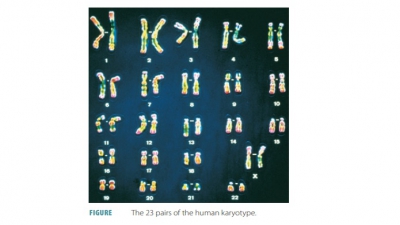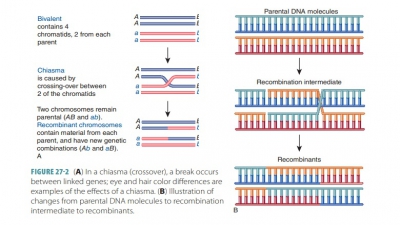Heredity: Environmental Factors
| Home | | Anatomy and Physiology | | Anatomy and Physiology Health Education (APHE) |Chapter: Anatomy and Physiology for Health Professionals: Heredity
Factors that Affect Expression of Single Genes, Mitochondrial Inheritance
Environmental
Factors
Environmental factors often influence or even override gene
expression. The human phenotype is easily changed while the genotype is not.
Drugs, pathogens, and other factors of a mother’s life can influence normal
gene expression during embryonic development. An example is the thalidomide disaster, in which this
sedative was taken by pregnant women to reduce morning sickness, but caused
their babies to have flipper-like hands and feet. In this case, the drug
overrode normal gene expression. The term phenocopies is used to describe environ-mentally produced phenotypes
that mimic genetic mutations.
Important environmental factors may influence genetic
expression after a baby is born. One example is when poor nutrition affects
normal brain growth, height, and general development of the body. A person who
has genes that should result in a tall body height can end up shorter because
of poor nutrition. Part of a gene’s environment is related to influences of
other genes. Hormonal deficits in childhood can result in abnormal skeletal
growth and body proportions. An example is cretinism,
which is a type of dwarfism that
results from hypothyroidism.
Factors that Affect Expression of Single Genes
Because of effects of the environment and various genes,
most genotypes are varied between individu-als. Identical twins do not have the
exact same symp-toms when they have an inherited illness. Penetrance,
expressivity, and pleidotropy are terms that describe various genotype
distinctions.
Penetrance
Penetrance is the all-or-none expression of an indi-vidual’s
genotype. Some allele combinations that cause disease are completely penetrant. Any individual who inherits a certain
genotype has some symptoms. A genotype is called incompletely penetrant when certain individuals do not express the
associated phenotype. An example of incomplete penetrance is polydactyly, in which the individual has
extra fingers or toes. Some people
inheriting the autosomal domi-nant allele will have more than five digits on
one hand or foot. Others who are known to have the allele, since they have a
parent or child with the condition, have 10 fingers and 10 toes. The majority
of traits are incompletely penetrant.
A gene’s penetrance is described numerically. An allele is
called 80% penetrant if 80 out of 100
people who have inherited the dominant polydactyly allele have extra digits.
Penetrance is also linked to the effects of environment, such as when a person
who inherits a genotype that raises the risks for lung cancer do not develop
cancer if the lungs are protected from smoke and pollution.
Expressivity
Expressivity is how dramatically a phenotype manifests
itself. A phenotype is called variably
expressive if symp-toms are of different intensities in different
individuals. This is usually how expressivity occurs. A person with polydactyly
may have one extra digit on both hands and one foot while another person may
have two extra digits on both hands and both feet. Another individual might
have only one extra fingertip. Polydactyly is vari-ably expressive as well as
being incompletely penetrant.
Pleidotropy
In pleidotropy, a
single genetic disorder exhibits sev-eral symptoms. Family members with
different symp-toms may seem to have different illnesses, when they really have
the identical pleiotropic disorder. Pleido-tropy occurs in genetic disorders
affecting just one protein that is present in different parts of the body.
An example is Marfan
syndrome, which is an autoso-mal dominant defect in the elastic connective
tissue protein called fibrillin. This
protein is abundant in the aorta, ribs, fingers, limb bones, and the lenses of
the eyes. Therefore, its symptoms include a sunken chest, very thin fingers,
lengthening of the limbs, and lens dislocation. The most severe symptom is
weakening of the aorta wall, which may cause the aorta to burst. If this
weakening is detected early in life, a synthetic graft can patch the affected
area and prevent death.
Genetic Heterogeneity
Genetic heterogeneity is defined as when the same phe-notype
results from actions of various genes. A good example is the almost 200 types
of hereditary deafness, which are each due to impaired actions of a differ-ent
gene. Different aspects of hearing are affected by different genes. Genetic
heterogeneity happens when different enzymes that catalyze identical biochemical
pathways are encoded by genes or when these genes encode different proteins
that make up a pathway. For example, blood clot formation may be caused by 11
different biochemical reactions. Clotting disorders may occur due to mutations
in genes that specify any of the enzymes that catalyze these reactions. Several
types of bleeding disorders may then develop.
Regulation of Gene Expression
The human genome has three basic levels of controls.
Protein-coding genes make up only the first control level. They account for
less than 2% of human cell DNA. This part is considered the “blueprint” for
pro-tein structure in humans. The other two control levels are referred to as small RNAs and epigenetic marks.
Small RNAs
The second level of controls appears to be related to many
RNA-only genes in the body. It is now believed that 80% of the genome may form
a parallel regulatory system. It may generate different small RNAs, includ-ing
microRNAs and small interfering RNAs. These molecules are mobile controllers
with direct actions upon DNA, other RNAs, or proteins. They can reduce the
effects of or inactive aggressive jumping genes known as retrotransposons, which usually copy themselves and
insert these copies into distant DNA sites. When this occurs, the retrotransposons
disable or hyperactivate their target genes.
Small RNAs control the timing of programmed cell death
during development and may prevent translation of other genes. When mutations occur, conditions such as schizophrenia or cancers of the prostate gland
and lungs may develop. Human genetic complexity is linked to small RNAs and
their control of gene
expression, mostly during growth and differentiation. Nucleotide
sequences of RNA- specifying DNA areas are being utilized for gene therapy
research. Drugs that interfere with RNA are being developed to slow or stop the
effects of genes related to cancer, Parkinson’s
disease, age-related macular
degeneration, and many other conditions.
Epigenetic Marks
The third level of controls involves epigenetic marks, stored in proteins and chemical groups that bind to DNA. Epigenetic marks are always
changing. They are also found in the packaging of chromatin inside cells.
Chemical tags such as acetyl and methyl groups are bound to DNA segments inside
cells as well as to histones. They determine if DNA is available for
transcription, also called acetylation, or silencing, also called methylation.
Via methylation, epigenetic marks also cause inactivation of one of the
female’s X chromosomes in the early embryonic phase.
The presence or absence of epigenetic marks may predispose
cells for transformation from normal states to cancer. Slight deviations in
these marks on certain chromosomes can result in severe diseases. Most
mater-nal and paternal genes turn on or off at the same time. However, this
balance is altered during gametogenesis, when certain genes are modified by
addition of a methyl group. This process, known as genomic imprinting, tags genes as either “paternal” or
“maternal.” The embryo then utilizes these tags and expresses either the
mother’s gene, while the father’s version remains idle or the reverse. With
every generation, old imprints are erased when new gametes are produced. All
chro-mosomes are newly imprinted. Epigenetic marks are easily “wiped away.” Sometimes
they are inherited by the next generation, causing changes to occur.
When imprinted genes mutate, pathological con-ditions can
occur. Examples of such conditions include:
■■ Angelman’s
syndrome: An autosomal recessive syndrome
characterized by severe mental retar-dation, incoherent speech, uncontrolled
laughter, and movements that are sudden and jerky; it is caused by a deletion
on chromosome 15 inherited from the mother.
■■ Prader–Willi
syndrome: A congenital metabolic condition
characterized by mild-to-moderate retardation, shortness, extreme obesity,
hypo-gonadism, hypotonia, and hyperphagia; it is
caused by a deletion on chromosome 15 inherited from the father. The genetic
cause of these two syndromes is identical: the deletion of a certain region of chromosome 15. The same allele can
have different effects based on the parent it came from.
Mitochondrial Inheritance
There are also 37 genes found in the mitochondria of cells.
These genes are referred to as mtDNA.
They are transmitted almost always from the mother to the off-spring. This is
because the ovum donates almost all the cytoplasm in the fertilized egg. Also,
sperm mtDNA is selectively destroyed by elimination
factors found in both the sperm and the egg. Many rare disorders are linked
to mitochondrial inheritance, which is also called extranuclear inheritance. While the majority of these disorders
involve mitochondrial oxidative phos-phorylation abnormalities, some cause
unusual neu-rological problems or degenerative muscle disorders. It is
suspected that Alzheimer’s disease and Parkinson’s disease may be linked to
mitochondrial inheritance.
1. Identify factors that may alter gene expression.
2. Explain what small RNAs control.
3. What does genomic imprinting do in relation to genes?


